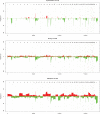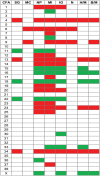Canine Mammary Tumours Are Affected by Frequent Copy Number Aberrations, including Amplification of MYC and Loss of PTEN
- PMID: 25955013
- PMCID: PMC4425491
- DOI: 10.1371/journal.pone.0126371
Canine Mammary Tumours Are Affected by Frequent Copy Number Aberrations, including Amplification of MYC and Loss of PTEN
Abstract
Background: Copy number aberrations frequently occur during the development of many cancers. Such events affect dosage of involved genes and may cause further genomic instability and progression of cancer. In this survey, canine SNP microarrays were used to study 117 canine mammary tumours from 69 dogs.
Results: We found a high occurrence of copy number aberrations in canine mammary tumours, losses being more frequent than gains. Increased frequency of aberrations and loss of heterozygosity were positively correlated with increased malignancy in terms of histopathological diagnosis. One of the most highly recurrently amplified regions harbored the MYC gene. PTEN was located to a frequently lost region and also homozygously deleted in five tumours. Thus, deregulation of these genes due to copy number aberrations appears to be an important event in canine mammary tumour development. Other potential contributors to canine mammary tumour pathogenesis are COL9A3, INPP5A, CYP2E1 and RB1. The present study also shows that a more detailed analysis of chromosomal aberrations associated with histopathological parameters may aid in identifying specific genes associated with canine mammary tumour progression.
Conclusions: The high frequency of copy number aberrations is a prominent feature of canine mammary tumours as seen in other canine and human cancers. Our findings share several features with corresponding studies in human breast tumours and strengthen the dog as a suitable model organism for this disease.
Conflict of interest statement
Figures







Similar articles
-
Characterisation of genome-wide structural aberrations in canine mammary tumours using single nucleotide polymorphism (SNP) genotyping assay.Pol J Vet Sci. 2019 Mar;22(1):133-141. doi: 10.24425/pjvs.2019.127080. Pol J Vet Sci. 2019. PMID: 30997777
-
Malignant canine mammary tumours: Preliminary genomic insights using oligonucleotide array comparative genomic hybridisation analysis.Vet J. 2017 Apr;222:68-71. doi: 10.1016/j.tvjl.2017.03.005. Epub 2017 Mar 28. Vet J. 2017. PMID: 28392153
-
Expression and significance of PTEN in canine mammary gland tumours.Res Vet Sci. 2008 Oct;85(2):383-8. doi: 10.1016/j.rvsc.2007.10.015. Epub 2007 Dec 20. Res Vet Sci. 2008. PMID: 18082231
-
PTEN and Other PtdIns(3,4,5)P3 Lipid Phosphatases in Breast Cancer.Int J Mol Sci. 2020 Dec 2;21(23):9189. doi: 10.3390/ijms21239189. Int J Mol Sci. 2020. PMID: 33276499 Free PMC article. Review.
-
The INPP4B paradox: Like PTEN, but different.Adv Biol Regul. 2021 Dec;82:100817. doi: 10.1016/j.jbior.2021.100817. Epub 2021 Jun 16. Adv Biol Regul. 2021. PMID: 34216856 Review.
Cited by
-
Establishment and molecular characterization of novel luminal A and luminal B canine mammary cancer cell lines for comparative oncology.Vet World. 2025 Jun;18(6):1725-1740. doi: 10.14202/vetworld.2025.1725-1740. Epub 2025 Jun 26. Vet World. 2025. PMID: 40689167 Free PMC article.
-
Comprehensive Analysis of Clinically Relevant Copy Number Alterations (CNAs) Using a 523-Gene Next-Generation Sequencing Panel and NxClinical Software in Solid Tumors.Genes (Basel). 2024 Mar 23;15(4):396. doi: 10.3390/genes15040396. Genes (Basel). 2024. PMID: 38674331 Free PMC article.
-
Integrated Study of Canine Mammary Tumors Histopathology, Immunohistochemistry, and Cytogenetic Findings.Vet Sci. 2024 Sep 4;11(9):409. doi: 10.3390/vetsci11090409. Vet Sci. 2024. PMID: 39330788 Free PMC article.
-
Machine learning determines stemness associated with simple and basal-like canine mammary carcinomas.Heliyon. 2024 Feb 24;10(5):e26714. doi: 10.1016/j.heliyon.2024.e26714. eCollection 2024 Mar 15. Heliyon. 2024. PMID: 38439848 Free PMC article.
-
Multiplexed Autoantibody Signature for Serological Detection of Canine Mammary Tumours.Sci Rep. 2018 Oct 25;8(1):15785. doi: 10.1038/s41598-018-34097-0. Sci Rep. 2018. PMID: 30361548 Free PMC article.
References
-
- Bronson RT. Variation in age at death of dogs of different sexes and breeds. Am J Vet Res. 1982; 43: 2057–2059. - PubMed
-
- Boldizsar H, Szenci O, Muray T, Csenki J. Studies on canine mammary tumours. I. Age, seasonal and breed distribution. Acta Vet Hung. 1992; 40: 75–87. - PubMed
-
- Egenvall A, Bonnett BN, Ohagen P, Olson P, Hedhammar A, von Euler H. Incidence of and survival after mammary tumors in a population of over 80,000 insured female dogs in Sweden from 1995 to 2002. Prev Vet Med. 2005; 69: 109–127. - PubMed
Publication types
MeSH terms
Substances
LinkOut - more resources
Full Text Sources
Other Literature Sources
Research Materials
Miscellaneous

